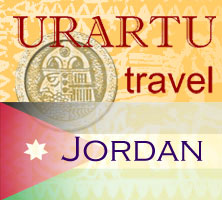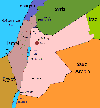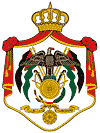About Jordan
General Information -- Geography -- Climate -- Religion -- Language -- Population and Ethnic Composition-- Government -- Administrative Division -- Time Zone -- Currency Exchange and Credit Cards -- Capital City -- Holidays -- Airports and Public Transportation -- Traditional Cuisine -- Brief History
General Information
One thing that overwhelms visitors in Jordan is the sense of history, with every stone seemingly carrying some historical significance. Amman, Jerash and Umm Qais were cities of the ancient Roman Decapolis, while biblical sites range from Bethany-beyond-the-Jordan, where Jesus was baptized, to Mt. Nebo, where Moses is said to have looked out over the Promised Land. Grandest of all, before Christ was born Nabatean stonemasons carved out their awe-inspiring capital at Petra from dramatic towering sandstone walls.
Jordan is also a great place to put down the history books and get active, whether it be diving off the coast of Aqaba, trekking with the Bedouin in the camel prints of Lawrence of Arabia, or hiking through stunning river gorges. Jordan’s excellent nature reserves in particular offer some of the most exciting adventure options in the Middle East.
Geography
Jordan can be divided into three major geographic regions: the Jordan Valley, the East Bank plateau and the desert. The fertile valley of the Jordan River is the dominant physical feature of the country’s western region, running from the Syrian border in the north, down the border with Israel and the Palestinian Territories and into the Dead Sea. The valley (part of the larger African Rift Valley) continues under the name Wadi Araba down to the Gulf of Aqaba. The majority of the population lives in a 70km-wide strip running the length of the country on the East Bank plateau. The remaining 80% of the country is desert, stretching to Syria, Iraq and Saudi Arabia.
Climate
Average daily maximum temperatures in Amman range from 12°C in January to 320C in August. Weather-wise April/May and September/October are probably the best times to visit Jordan and these months are considered peak season.
Summer is an uncomfortable time to visit the Jordan Valley, Desert Castles and Wadi Rum: daily temperatures are well in excess of 36°C and can peak at 49°C. At the other extreme, snow in Amman and Petra is not unheard of in winter, when desert night can be very cold. Even during winter Aqaba remains balmy.
Religion
Over 92% of the population are Sunni Muslims. A further 6% are Christians living mainly in Amman, Madaba, Karak and Salt. There are tiny Shiite and Druze groups.
Most Christians belong to the Greek Orthodox Church, but there are also some Greek Catholics, a small Roman Catholic community, and Syrian, Coptic and Armenian Orthodox communities.
Language
Arabic is the official language of Jordan. English is widely spoken, however, and in most cases is sufficient to get by.
Population and Ethnic Composition
The population of Jordan stood at about 5.8 million in 2005. About 1.8 million live in the capital Amman, and 700,000 more in neighbouring Zarqa. The majority (98%) of Jordanians are Arab (which includes the Bedouin); about two thirds of these are Palestinians. There are also small communities of Circassians, Chechens and Armenians who moved to the region during the Ottoman period.
Government
Jordan is a constitutional monarchy based on the constitution promulgated on January 8, 1952. Executive authority is vested in the king and his council of ministers. The king signs and executes all laws. His veto power may be overridden by a two-thirds vote of both houses of the National Assembly. He appoints and may dismiss all judges by decree, approves amendments to the constitution, declares war, and commands the armed forces. Cabinet decisions, court judgments, and the national currency are issued in his name. The council of ministers, led by a prime minister, is appointed by the king, who may dismiss other cabinet members at the prime minister's request. The cabinet is responsible to the Chamber of Deputies on matters of general policy and can be forced to resign by a two-thirds vote of "no confidence" by that body.
The constitution provides for three categories of courts – civil, religious, and special. Administratively, Jordan is divided into twelve governorates, each headed by a governor appointed by the king. They are the sole authorities for all government departments and development projects in their respective areas.
The Royal Armed Forces and General Intelligence Department of Jordan are under the control of the king.
Administrative Division
Administratively, Jordan is divided into 12 governorates, each headed by a governor appointed by the king. They are the sole authorities for all government departments and development projects in their respective areas. The governorates are subdivided into approximately 52 nahias.
Time Zone
Standard Time is 2 hours ahead Greenwich Mean Time (GMT+2).
Currency Exchange and Credit Cards
The currency in Jordan is the dinar (JD) which is made up of 1000 fils. You will often hear piaster used, which is 10 fils.
It is not difficult to change money in Jordan; most hard currencies are accepted. It is possible to survive in Jordan almost entirely on cash advances as ATMs abound in all but smallest towns.
Credit cards are widely accepted in mid-range and top-end hotels and restaurants and a few top-end shops.
There are plenty of moneychangers in Amman, Aqaba and Irbid, which are useful because they keep longer hours than the banks. Many only deal in cash but some take travelers cheques, usually for a commission.
Capital City
The site of Amman has been continuously occupied since 3500 BC. Biblical references to the city are numerous and indicate that by 1200 BC ‘Rabbath Ammon’ was the capital of the powerful Ammonites.
Amman was taken by Herod around BC and fell under the sway of Rome.
Philadelphia (as it was then known) was the seat of Christian bishops in the early Byzantine period, but the city declined and fell to the Sassanians (from Persia) in about AD 614. At the time of the Muslim invasion in about AD 636, the town was again thriving as a staging post of the caravan trade.
Amman was nothing more than a little village when a colony of Circassians resettled there in 1978. In 1900 it was estimated to have just 2000 residents. In 1921 it became the centre of Transjordan when King Abdallah made it his headquarters.
Built originally on seven hills (like Rome) Amman now spreads across 19 hills. The main hill is Jebel Amman, home to embassies and midrange/top-end hotels and restaurants. The Jebel Weibdeh and Abdali areas have more hotels, the distinctive blue dome of the King Abdullah Mosque, and the JETT and Abdali bus stations. West and south of these areas are glamorous Shmeisani and Abdoun, the most upmarket areas of Amman and the places to go for nightlife.
Holidays
In addition to the main Islamic holidays, Jordan observes the following holidays:
- 1 January – New Years Day
- 30 January – King Abdullah’s Birthday
- 22 March – Arab League Day
- 1 May – Labor Day
- 25 May – Independence Day
- 10 June – Army Day and Anniversary of the Great Arab Revolt
- 14 November – King Hussein’s Birthday
- 25 December – Christmas Day
Airports and Public Transportation
The main international airport is Queen Alia International Airport, 35 km south of Amman. Flights to Sharm el-Sheikh and occasional charters to Paris serve the smaller Aqaba airport. The Airport Express bus runs every half hour between 8am and midnight between the airport and the upper end of Abdali bus station
Jordan is such a small country that there is only one domestic air route, between Amman and Aqaba.
The three main bus stations in Amman are Abdali bus station for transport to the north and west; Wahadat bus station for the south; and Rahadan bus station for Amman and nearby towns.
All the major hotels have car rental offices.
Traditional Cuisine
The Bedouin specialty is mensaf, delicious spit-roasted lamb that is basted with spices until it takes on a yellowish appearance. It is served on a bed of rice and pine nuts, sometimes with the head of the lamb plonked in the centre and the cooking fat mixed into the rice. Honoured guests get the eyes, less honoured guests get the tongue. The dish is served with a sauce of cooked yogurt that has been mixed with the leftover cooking fat.
Another local favourite is maqlubbeh – steamed rice topped with grilled slices of eggplant or meat, grilled tomato and pine nuts.
In Wadi Rum you might be lucky enough to be offered a Bedouin barbecue from the zarb, a pit oven buried in the desert sand.
Dessert here, as in many parts of the Middle East, may be kunafa or muhalabiyya (a milk custard containing pistachio nuts).
The universal drink of choice is sweet black tea (coffee comes a close second). Other options include yansoon (aniseed herbal tea) and zaatar (thyme-flavoured tea).
Brief History
Jordan has always been a crossroads for the Middle East’s great civilizations, although most invaders have simply passed through en route to more prized possessions.
In 333 BC,
Alexander the Great stormed through Jordan on his way to Egypt. After Alexander’s death in 323 BC, Ptolemy I gained Egypt, Jordan and parts of Syria. In southern Jordan, the Nabataeans, a semi-nomadic Arabian tribe that controlled lucrative trade routs, built its splendid capital at Petra, while the Roman Empire controlled much of the rest of the country.
After periods of occupation by the Seleucids, Sassanians and Byzantines, Jordan was overrun by the armies of Islam in the 7th century, Jordan came under the control of the Umayyad Empire centered in Damascus.
In AD 747 an earthquake devastated much of Jordan, ushering on the rule of the Abbasids, who were in turn followed by Cairo-based Fatimids in AD 969, and then, from 1037, by the Seljuk Turks.
In the 11th century, Pope Urban II launched the Crusades, capturing Jerusalem in 1099, slaughtering countless inhabitants and devastating the area. The Crusaders took control of most of Jordan by about 1115, built fortresses at Karak, Shobak and Petra.
In the 12th century, the armies of Nur ad-Din, and later Salah ad-Din (Saladin), reunited the Arab and Islamic world and occupied most of the Crusader strongholds in Jordan. The Mamluks, former soldier- slaves, finally expelled the Crusaders in 1250. The Ottoman Turks defeated the Mamluks in 1516 and ruled until WWI.
In June 1916 the Arabs, with the assistance of TE Lawrence (“Laurence of Arabia”), launched the Arab Revolt and helped the British drive the Turks from the region. In return, the Arabs were given British assurances that they would be allowed to establish an independent Arab state.
The newly formed League of Nations instead gave Britain a mandate over Palestine, and shortly afterwards the state of Transjordan, lying between Iraq and the East Bank of the Jordan River, was made a separate entity under King Abdullah. What remained of Palestine corresponded more or less to present-day Israel and the Palestinian Territories.
Directly after WWII, the British threw in the towel and handed over the mess to the UN, which voted in favor of the partition of Palestine knot separate Arab and Jewish states. But, agreement could not be reached and the Arab- Israeli War broke out in 1948, prompting many Palestinians to flee to Transjordan and ending with a comprehensive victory for Israeli; it ensured Jewish occupation of the zones allocated to them under the UN partition plan as well as almost all those assigned to the Palestinian Arabs. Transjordan exploited the situation and occupied the West Bank and part of Jerusalem. This done, King Abdullah shortened his fledgling county’s name to Jordan.
King Abdullah was assassinated in 1951. He was succeeded the following year by his grandson Hussein, who took the throne at the age of just 17 managed to hold it for 48 years through insurrection attempts, two wars with the Israelis and a virtual civil war with the Palestinians. He reigned until his death in 1999.
In the 1960s aid poured in from the USA and Jordan enjoyed a boom in tourism, mainly in Jerusalem’s old city. The situation was radically altered by the Six Day War of 1967, in which Jordan lost the West Bank and its half of Jerusalem to occupying Israeli forces. In return it gained a huge influx of Palestinian refugees.
As the Palestinians, particularly the Palestine Liberation Organization (PLO), became more militant against the Israeli occupation in the early 1970s they also posed a danger to King Hussein, given that most operated from Jordanian territory. They came to contest power on the kingdom, angered in part by Hussein’s claim to be the leader of the Palestinian people. After some bloody fighting on 1971, the bulk of the radicals were forced to cross the border to Lebanon, where they would later become one part among many of that country’s woes.
King Hussein’s diplomatic skills were stretched to the fullest when, during the 1991 Gulf War, he refused to side against Iraq, fearing unrest among Jordan’s Palestinian populace. For the third time in 45 years, Jordan experienced a massive refugee inflow, with as many as 500,000 Palestinians previously working in the Gulf states fleeing to Jordan.
Jordan recovered remarkably well from that conflict and, despite fears lf the threat of Islamic extremism, King Hussein went ahead and signed a full peace treaty with Israel in 1994.
When King Hussein finally succumbed in February 1999 to the cancer that had been ailing him for so long, his son and nominated heir, Abdullah II, became king of a comparatively stable and prosperous country.



